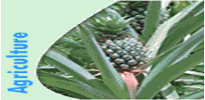Mauritania: Mauritania Agriculture Profile
2012/03/19
Seasonably dry conditions prevail
The seasonal rains have not yet started and farmers are currently preparing their fields. Planting of the 2011 cereal crops is scheduled to start in July with the onset of the rains.
Cereal production recovered in 2010
Favourable weather conditions throughout the cropping season resulted in a good cereal crop last year. Pastures have regenerated countrywide. The official estimate puts the 2010 aggregate cereal production at about 259 000 tonnes, an increase of 52 % over the drought affected crop of 2009. This, in addition to favourable crop prospects in neighbouring countries, particularly in Senegal and Mali, lead to a generally satisfactory food availability so far in the 2010/11 marketing year (November/October).
High wheat prices affect access to food
Mauritania is a food-deficit country where agricultural production fluctuates markedly from year to year due to weather variations. Domestic cereals production only covers one third of the national utilisation requirement in a normal year. The country is highly dependent on imports of coarse grains (millet and sorghum) from its neighbours, Senegal and Mali, as well as wheat purchased on the international market. Food prices are therefore a key factor to access to food by the majority of the Mauritanian people. Prices of millet and sorghum have been mostly stable following good harvests in neighbouring countries. Wheat and rice prices also remained stable throughout July 2010. However, the recent sharp rise in international food prices, notably of wheat, maize, sugar and oils, has led to high inflationist pressure on the domestic food market eroding the purchasing power of urban and rural consumers. Average wheat prices in Nouakchott are reported to have increased by 38 % year-on year to March 2011.
06/12/2010 Harvest prospects are favourable

Following the first showers in June, good rains fell from July through September over most of southern and central Mauritania. As a result, soil moisture has been generally adequate to meet crops’ water requirement since the beginning of the growing season, allowing satisfactory crop development in main producing zones. Harvesting of millet and sorghum has started. Pastures have regenerated countrywide, improving livestock conditions.

Last year, cereal output declined by about 24 % compared to 2008, following irregular rains that limited areas planted in the irrigated sector and affected yields of diéri (rainfed) crops.
High wheat prices will affect access to food

Mauritania is a food-deficit country where agricultural production fluctuates markedly from year to year due to weather variations. Domestic cereals production only covers one third of the national utilisation requirement in a normal year. The country is highly dependent on imports of coarse grains (millet and sorghum) from its neighbours, Senegal and Mali, as well as wheat purchased on the international market. Food prices are therefore a key factor to access to food by the majority of the Mauritanian people. Prices of millet and sorghum remained mostly stable this year following good harvests in neighbouring countries. Wheat and rice prices also remained stable throughout July reflecting trends on the international market. However, the recent sharp rise in international wheat prices is likely to lead to high inflationist pressure on the domestic food market and erode the purchasing power of urban and rural consumers. Retail wheat prices in Nouakchott are reported to have increased by 21 % between July and September.
The following is a list of the top agricultural commodity exports from Mauritania in 2007.
| Rank | Product | Quantity (in Tons) | Value (in Thousands)* | Unit Value* (Per Ton) |
|
1 |
Skins With Wool Sheep | 357 | 663 | 1,857 |
| 2 | Tea | 762 | 493 | 647 |
| 3 | Skinsdry Sltsheep | 91 | 145 | 1,593 |
| 4 | Food Wastes | 205 | 63 | 307 |
| 5 | Hidesdry S.Cattle | 12 | 40 | 3,333 |
| 6 | Macaroni | 32 | 28 | 875 |
| 7 | Milk Skimmed Dry | 12 | 27 | 2,250 |
| 8 | Sugar Confectionery | 23 | 16 | 696 |
| 9 | Hides Wet Salted Cattle | 14 | 14 | 1,000 |
| 10 | Tangerines, mandarins, clem. | 15 | 12 | 800 |
| 11 | Skinsdry Slt Goat | 12 | 12 | 1,000 |
| 12 | Olives Preserved | 4 | 10 | 2,500 |
| 13 | Onions, dry | 46 | 10 | 217 |
| 14 | Sugar Refined | 3 | 6 | 2,000 |
| 15 | Meat of Beef,Drd, Sltd,Smkd | 9 | 6 | 667 |
| 16 | Food Prep Nes | 2 | 5 | 2,500 |
| 17 | Oranges | 5 | 4 | 800 |
| 18 | Beverage Non-Alc | 4 | 3 | 750 |
| 19 | Vegetables fresh nes | 6 | 2 | 333 |
| 20 | Plums and sloes | 1 | 2 | 2,000 |
* International commodity prices
- Mauritania News
-
- BOTSWANA: Routes Africa forum aims to improve African air connectivity
- BOTSWANA: Economic integration is helping boost trade and investment in Africa
- BOTSWANA: Africa’s economic growth is likely to be slower in the intervening years
- BOTSWANA: Beyond Commodities: How African Multinationals Are Transforming
- EGYPT: Egypt, Mauritania sign six agreements, memos
- TURKEY: Turkey to build dams in Mauritania and Senegal
- Trending Articles
-
- AZERBAIJAN: EU to realize new twinning projects in Azerbaijan
- UNITED STATES: My Diplomatic Moment with Mohammed Ali
- ALGERIA: Algeria looks to boost capital markets liquidity
- CHINA: Djibouti partners with China to develop local infrastructure and global trade routes
- CHINA: United States sees China investment talks ‘productive’ after new offers
- EGYPT: Egypt's micro-credit NGO lifting women out of poverty






.gif?1356023993)


